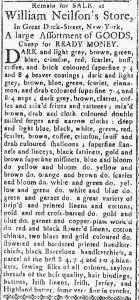What was advertised in a colonial American newspaper 250 years ago today?

“For SALE at William Neilson’s Store.”
In addition to advertising his wares in the New-York Gazette and Weekly Mercury, the New-York Gazette or Weekly Post-Boy, and the New-York Journal, William Neilson also inserted a notice in the Connecticut Journal and New-Haven Post-Boy. Yesterday I examined the iteration of the advertisement that appeared in the March 1, 1770, edition of the New-York Journal, focusing on the nota bene about his prices remaining the same as before the nonimportation agreement went into effect. The version that ran in the Connecticut Journal listed many of the same goods, but did not deploy copy identical to the advertisement in the New-York Journal. Most significantly, it did not include the nota bene about prices. Why not?
After further investigation, I discovered that the nota bene was not part of the advertisement when it first appeared in any of newspapers printed in New York. It first ran in the February 22, 1770, edition of the New-York Journal without the additional note offering assurances that Neilson did not take advantage of the nonimportation agreement to engage in price gouging. The advertisement did not appear in the new issues of the New-York Gazette and Weekly Mercury and the New-York Gazette or Weekly Post-Boy, published four days later. Instead, it made its next appearance in the March 1 edition of the New-York Journal, now with the nota bene. On March 5 the advertisement – identical copy, including the nota bene – did appear in the other two New York newspapers. The staggered appearance of the advertisements and the addition of the nota bene suggest that Neilson felt some urgency to inform prospective customers and the rest of the community that he did not jack up his prices. Perhaps he had heard rumors or been confronted directly, prompting him to advertise more widely than he originally intended. By the time he made that determination, it may have been too late to update the copy he sent to the Connecticut Journal.
Rather than merely noting a benefit to his customers, the nota bene that eventually appeared at the conclusion of Neilson’s advertisements may very well have been an exercise in reputation management. Rarely did merchants and shopkeepers update their advertisements in the 1760s and 1770s. They usually submitted copy that ran for weeks or even months. Yet Neilson made an addition to his advertisement and then published the revised version in its entirety in two more newspapers, increasing the funds he expended on advertising. If his reputation was at stake, he may have considered doing so a necessity well worth the additional expense.

